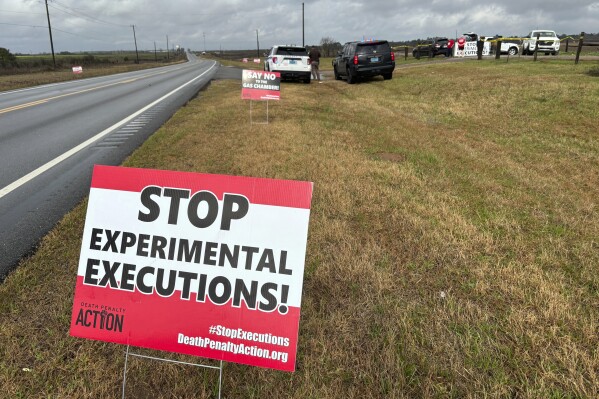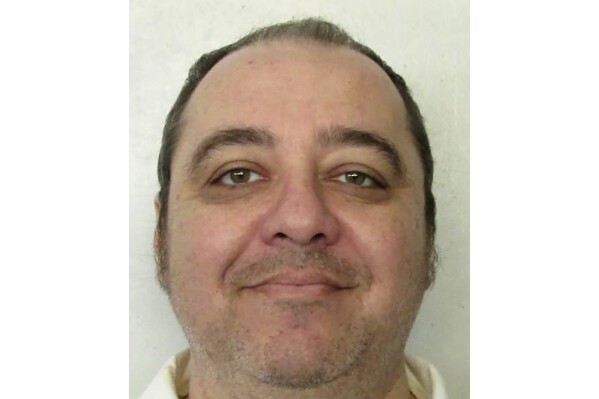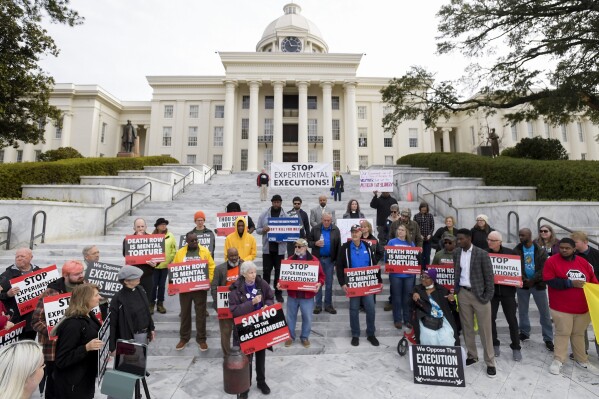AMERIKA PRISON NATION INC.
What happened at the nation’s first nitrogen gas execution: An AP eyewitness account

Anti-death penalty signs placed by activists stand along the road heading to Holman Correctional Facility in Atmore, Ala., ahead of the scheduled execution of Kenneth Eugene Smith, Thursday, Jan. 25, 2024. On Thursday, Alabama put Smith to death with nitrogen gas. (AP Photo/Kim Chandler, File)

This undated photo provided by the Alabama Department of Corrections shows inmate Kenneth Eugene Smith, who was convicted in a 1988 murder-for-hire slaying of a preacher’s wife. On Thursday, Jan. 25, 2024, Alabama put Smith to death with nitrogen gas. (Alabama Department of Corrections via AP, File)
BY KIM CHANDLER
Updated 5:58 PM MST, January 26, 2024Share
ATMORE, Ala. (AP) — As witnesses including five news reporters watched through a window, Kenneth Eugene Smith, who was convicted and sentenced to die in the 1988 murder-for hire slaying of Elizabeth Sennett, convulsed on a gurney as Alabama carried out the nation’s first execution using nitrogen gas.
Critics who had worried the new execution method would be cruel and experimental said Smith’s final moments Thursday night proved they were right. Alabama Attorney General Steve Marshall, however, characterized it on Friday as a “textbook” execution.
Here is an eyewitness account of how it unfolded. Times, unless otherwise noted, are according to a clock on the execution chamber wall at the William C. Holman Correctional Facility.

Alabama man shook violently on gurney during first-ever nitrogen gas execution

Alabama executes a man with nitrogen gas, the first time the new method has been used
The curtains between the viewing room and the execution chamber opened at 7:53 p.m. Smith, wearing a tan prison uniform, was already strapped to the gurney and draped in a white sheet.
A blue-rimmed respirator mask covered his face from forehead to chin. It had a clear face shield and plastic tubing that appeared to connect through an opening to the adjoining control room.
FINAL WORDS
The prison warden entered the chamber, read the death warrant setting his execution date and held a microphone for Smith to speak any final words.
“Tonight Alabama causes humanity to take a step backwards,” Smith began. He moved his fingers to form an “I love you” sign to family members who were also present. “I’m leaving with love, peace and light. ... Love all of you.”
The Sennett family watched from a viewing room that was separate from the one where members of the media and Smith’s attorney were seated.
THE EXECUTION IS GREENLIGHTED
Marshall, the attorney general, gave prison officials the OK to begin the execution at 7:56 p.m. That was the final confirmation from his office that there were no court orders preventing it from going forward.
A corrections officer in the chamber approached Smith and checked the side of the mask.
The Rev. Jeff Hood, Smith’s spiritual advisor took a few steps toward Smith, touched him on the leg and they appeared to pray.
The Department of Corrections had required Hood to sign a waiver agreeing to stay 3 feet (0.9 meters) away from Smith’s gas mask in case the hose supplying the nitrogen came loose.
THRASHING AND GASPING BREATHS
Smith began to shake and writhe violently, in thrashing spasms and seizure-like movements, at about 7:58 p.m. The force of his movements caused the gurney to visibly move at least once. Smith’s arms pulled against the against the straps holding him to the gurney. He lifted his head off the gurney the gurney and then fell back.
The shaking went on for at least two minutes. Hood repeatedly made the sign of the cross toward Smith. Smith’s wife, who was watching, cried out.
Smith began to take a series of deep gasping breaths, his chest rising noticeably. His breathing was no longer visible at about 8:08 p.m. The corrections officer who had checked the mask before walked over to Smith and looked at him.
THE EXECUTION ENDS
The curtains were closed to the viewing room at about 8:15 p.m.
Alabama Corrections Commissioner John Q. Hamm told reporters afterward that the nitrogen gas flowed for approximately 15 minutes. The state attorney general’s office declined Friday to discuss at what time the nitrogen gas began flowing, or at what time a monitor connected to Smith during the execution showed that his heart had stopped beating.
State officials said Smith was pronounced dead at 8:25 p.m.
___
Chandler was one of five media witnesses for Smith’s execution by nitrogen hypoxia. She has covered approximately 15 executions in Alabama over the last two decades, including the state’s first lethal injection.
Alabama man shook violently on gurney during first-ever nitrogen gas execution
A man put to death using nitrogen gas shook and convulsed on the gurney as Alabama carried out the first-of-its-kind execution that once again placed the United States at the forefront of the debate over capital punishment. (Jan. 26)
BY KIM CHANDLER
January 26, 2024

ATMORE, Ala. (AP) — A man put to death using nitrogen gas shook and convulsed for minutes on the gurney as Alabama carried out the first-of-its-kind execution that has ignited debate over the humaneness of the method.
Breathing through a nitrogen-filled face mask that deprived him of oxygen, 58-year-old convicted killer Kenneth Eugene Smith convulsed in seizurelike spasms for at least two minutes of the 22-minute execution by nitrogen hypoxia Thursday. The force of his movements at times caused the gurney to visibly shake. That was followed by several minutes of gasping breathing until his breath was no longer perceptible.
Smith’s supporters expressed alarm at how the execution played out, saying it was the antithesis of the state’s promise of a quick and painless death. But Alabama’s attorney general characterized the execution as “textbook” during a Friday news conference.
“As of last night, nitrogen hypoxia as a means of execution is no longer an untested method. It is a proven one,” Alabama Attorney General Steve Marshall said, extending an offer of help for states considering adopting the method.

Alabama calls nitrogen execution method painless and humane, but critics are raising doubts

Why are states like Alabama, which is planning to use nitrogen gas, exploring new execution methods?
Asked about Smith’s shaking and convulsing on the gurney, Alabama Corrections Commissioner John Q. Hamm said they appeared to be involuntary movements.
“That was all expected and was in the side effects that we’ve seen or researched on nitrogen hypoxia,” Hamm said. “Nothing was out of the ordinary from what we were expecting.”
Marshall said he anticipated Alabama “will definitely have more nitrogen hypoxia executions.” More than 40 death row inmates have selected nitrogen as their preferred execution method over lethal injection but did so at a time when the state hadn’t developed nitrogen procedures.
AP AUDIO: Alabama man shook violently on gurney during first-ever nitrogen gas execution.
AP correspondent Sagar Meghani has the story.
Attorneys for those inmates have asked the court to order Alabama to turn over records and information about Smith’s execution. Litigation will almost certainly focus on Smith’s convulsions and movements during the execution.
“The State promised the world the most humane method of execution known to man. Instead, Mr. Smith writhed and thrashed before he died. No further executions should take place by this method until the events of this evening are examined by an independent body,” Assistant Federal Defender John Palombi, who represents death row inmates who requested nitrogen, said in a statement.
Smith’s spiritual adviser, the Rev. Jeff Hood, agreed that the execution did not match the state attorney general’s prediction that Smith would lose consciousness in seconds followed by death within minutes.
“We didn’t see somebody go unconscious in 30 seconds. What we saw was minutes of someone struggling for their life,” said Hood, who attended the execution.
Dr. Philip Nitschke, a euthanasia expert who designed a suicide pod using nitrogen gas and appeared as an expert witness for Smith, said the description of Smith’s thrashing matches what he would expect to happen when nitrogen gas is used in a mask and someone holds their breath or takes the smallest possible breaths.
“I think this outcome is inevitable if the nitrogen gas is to be used in execution where people do not want to die and will not cooperate,” Nitschke said.
Outside the country, the European Union and the U.N. Human Rights Office expressed regret Friday over the execution. The 27-nation EU and the Geneva-based U.N. rights office say the death penalty violates the right to life and does not deter crime.
Smith, who was paid $1,000 to kill an Alabama woman more than 30 years ago, said in a final statement: “Tonight Alabama causes humanity to take a step backwards. I’m leaving with love, peace and light.”
He made the “I love you sign” with his hands toward family members who were witnesses. “Thank you for supporting me. Love, love all of you,” Smith sai
Alabama Gov. Kay Ivey said the execution was justice for the murder-for-hire killing of 45-year-old Elizabeth Sennett in 1988.
“After more than 30 years and attempt after attempt to game the system, Mr. Smith has answered for his horrendous crimes,” Ivey said in a statement. “I pray that Elizabeth Sennett’s family can receive closure after all these years dealing with that great loss.”
“Tonight Alabama causes humanity to take a step backwards. ... I’m leaving with love, peace and light.”
Kenneth Eugene Smith, in a final statement
Mike Sennett, the victim’s son, said Thursday night that Smith “had been incarcerated almost twice as long as I knew my mom.”
“Nothing happened here today is going to bring Mom back. It’s kind of a bittersweet day. We are not going to be jumping around, whooping and holler, hooray and all that,” he said. “I’ll end by saying Elizabeth Dorlene Sennett got her justice tonight.”
Alabama had previously attempted to execute Smith in 2022, but the lethal injection was called off at the last minute because authorities couldn’t connect an IV line.
The execution came after a last-minute legal battle in which his attorneys contended the state was making him the test subject for an experimental execution method that could violate the constitutional ban on cruel and unusual punishment. Federal courts rejected Smith’s bid to block it, with the final ruling coming Thursday night from the U.S. Supreme Court.
Liberal Justices Sonia Sotomayor, Elena Kagan and Ketanji Brown Jackson dissented.
“Having failed to kill Smith on its first attempt, Alabama has selected him as its ‘guinea pig’ to test a method of execution never attempted before. The world is watching,” Sotomayor wrote.
The White House also expressed concern over the execution method, with Press Secretary Karine Jean-Pierre saying during a media briefing Friday that reports about Smith and his death were “very troubling.”
Sennett was found dead in her home March 18, 1988, with eight stab wounds in the chest and one on each side of her neck. Smith was one of two men convicted in the killing. The other, John Forrest Parker, was executed in 2010.
Prosecutors said they were each paid $1,000 to kill Sennett on behalf of her pastor husband, who was deeply in debt and wanted to collect on insurance. The husband, Charles Sennett Sr., killed himself when the investigation focused on him as a suspect, according to court documents.



